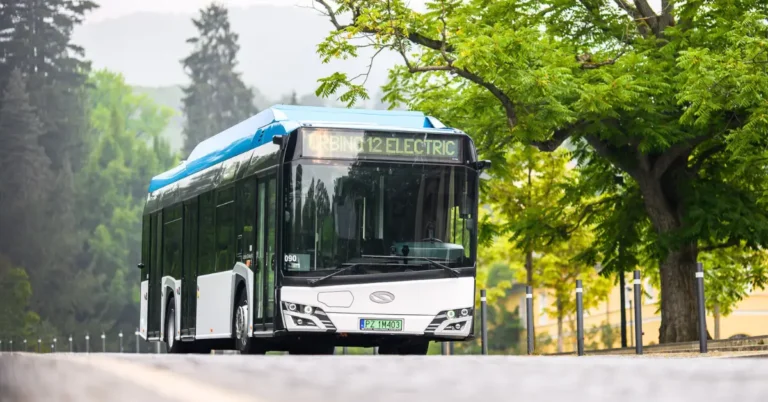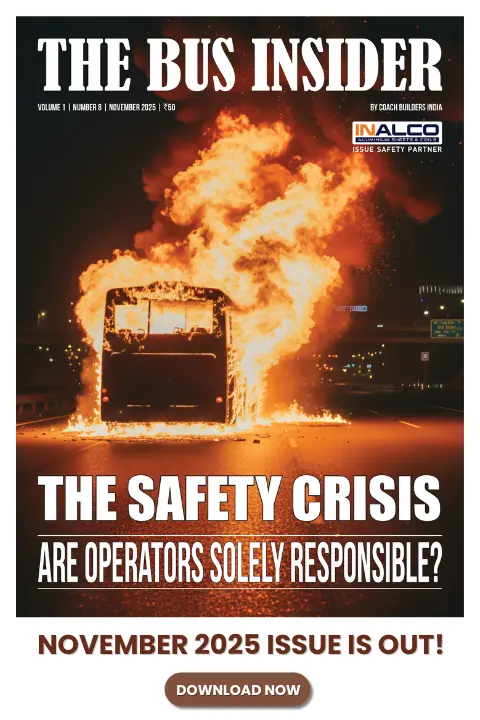ICCT Research: Situational Analysis of Bus-Based Public Transport Supply in Delhi
.webp?updatedAt=1762337464431)
Delhi NCT. Source ICCT.
Delhi, a rapidly expanding metropolis, faces significant challenges in ensuring equitable access to public transportation, as approximately 31% of buildings are more than 500 meters from the nearest bus stop.
Nearly one in three Delhi neighborhoods lacks walkable access to a bus stop, impacting communities most reliant on public transport for daily mobility.

A recent study by the International Council on Clean Transportation (ICCT) titled “Neighborhood Public Transit Services: Situational Analysis of Bus-Based Public Transport Supply in Delhi“ identifies the mismatch between mobility patterns and service design, offering a compelling, data-backed case for restructuring Delhi’s bus network to include short-distance, neighborhood-level electric buses.
The study offers a unique, highly detailed view of Delhi’s bus service coverage using advanced GIS tools. GIS tools, ward-level demographic data, and official route information from the Delhi Transport Corporation (DTC) and Delhi Integrated Multi-Modal Transit System (DIMTS), the analysis identifies critical access gaps.
About 31% of urban neighborhoods in Delhi fall outside a 500-meter radius of any bus stop, a benchmark defined under India’s Transit-Oriented Development (TOD) policy as the standard for walkable public transport access.
.jpg?updatedAt=1762337570191)
Bhaumik Gowande, Associate Researcher at ICCT, adds, “Our GIS-based research highlights critical gaps and opportunities in neighborhood-level access to public bus transit across Delhi NCT. Mapping these gaps enables targeted, equitable service provision.”
Certain municipal wards, such as Deoli, Jaitpur, Sangam Vihar, Mustafabad, Ghonda, Sainik Enclave, Hari Nagar Extension, and Prem Naga,r were found to have zero buildings within 500 meters of a bus stop.
This highlights both a major service gap and the challenge of using 12-meter buses in dense, narrow-road areas.
| % of Buildings Not Accessible | Name of the Wards |
| 100% | Deoli, Hari Nagar Extension, Jaitpur, Sangam Vihar-A, Sainik Enclave, Ghonda, Mustafabad, Prem Nagar |
| 90-99% | Karawal Nagar-East, Kirari, Sangam Vihar-B, Ballimaran, Binda Pur |
| 80-89% | Sangam Vihar-C, Sant Naga |
| 70-79% | Saboli, Nithari, Said-UI-Ajaib, Sadh Nagar, Vikas Nagar, Aya Nagar, Harsh Vihar |
| 60-69% | Hastsal, Sarup Nagar, Mohan Garden, Sagarpur, Bazar Sita Ram, Zakir Nagar, Dayalpur, Gautam Puri, Tigri, Raj Nagar, Aman Vihar, Vasant Kunj, Baprola |
| 50-59% | Badarpur, West Patel Nagar, Nawada, Matiala, Mukundpur, Uttam Nagar, Madanpur Khadar West, Subhash Mohalla, Begumpur, Khanpur, Manglapuri, Budh Vihar, Brij Puri, Nilothi, Madhu Vihar |
The study notes that while Delhi has expanded its metro network and added new buses through government programs, many areas still lack adequate access. The City also sees 60% of daily trips under 4 km and 80% under 6 km, yet its bus network remains geared toward long-haul trunk routes.
For many residents, especially in underserved wards, the first and last mile of daily commutes often involve extended walking or costly informal transport modes. This disconnect lowers the utility of high-capacity fixed-route systems and reinforces dependence on private and motorized travel, which contributes to emissions within residential neighbourhoods.
In neighborhoods like Dwarka, where intra-sub-city travel dominates and the average trip length is just 4.3 kilometers, the absence of localized public bus connectivity even in metro-accessible zones highlights a structural gap in multimodal integration.
Solo Female Travelers on the Rise in India: IntrCity Insights
Addressing The Issues

To address these issues, the ICCT study advocates for a reorientation of Delhi’s public bus network around neighborhood-level service models.
Specifically, it recommends deploying 9-meter electric buses on roads 7 meters or wider within a maximum operational trip distance ranging between 10-12 km.
These smaller vehicles are suited to operating in dense urban settlements and can navigate narrower lanes where 12-meter standard buses cannot, and shorter trip length will faster operational trips with high frequency and lesser headways.
These electric buses would enable a shift from private and intermediate transport to electric buses, enabling decarbonisation of transport at the neighbourhood level.
This recommendation aligns with the Delhi Government’s launch of the Delhi Electric Vehicle Interconnector (DEVI) initiative.
These e-buses, recently introduced by Chief Minister Rekha Gupta, are designed to function as last-mile and intra-zonal connectors.
ICCT India played a technical advisory role in developing the pilot, including contributing to international consultations, identifying assessment parameters, validating proposed routes, and facilitating stakeholder engagement.
To ensure operational efficiency and support charging opportunities for e-buses, the study recommends limiting neighborhood bus routes to a 5-kilometer radius from designated depots.
This service radius minimizes dead kilometers, non-revenue-generating travel time from depot to route start, —and enhances the feasibility of electric operations within constrained urban environments.
By introducing this parameter, the study offers a scalable model for localized e-bus deployment not only in Delhi but potentially across other Indian cities experiencing similar urban growth patterns and mobility gaps.
Amit Bhatt, Managing Director of ICCT India, underscores the potential ripple effect of the DEVI model: “If successful, this scheme could not only benefit Delhi but also have a strong ripple effect across other cities in the country.”
While the report highlights accessibility gaps, the larger ambition is systemic decarbonization. Encouraging modal shift from private and informal vehicles to electric neighborhood buses directly supports India’s clean mobility and emissions reduction targets. As buses remain among the most energy-efficient motorized modes, optimizing their deployment can yield significant environmental gains.
The European Electric Bus Statistics Report 2024/25: The Key Takeaways
Revathy Pradeep, ICCT Researcher, emphasizes the alignment with Delhi’s air quality goals: “To achieve its clean air and accessibility targets, Delhi must actively integrate electric neighborhood buses into its policy frameworks,.” he adds.
The ICCT study serves as a diagnostic and prescriptive framework for neighborhood-based transit in Delhi. By identifying access gaps, proposing route design strategies based on road-width and trip length data, and recommending an electric-first deployment model within a 5-km radius of depots, the study charts a roadmap for sustainable and inclusive urban mobility.
As Indian cities continue to grow, the adoption of neighborhood electric buses, supported by data, enabled by policy, and designed for local contexts, could mark a turning point in the country’s transit transformation.
The question now is not whether more buses are needed, but how and where they should be deployed to achieve the twin goals of decarbonization and equitable access.
This is a summarized version of a white paper titled “Neighborhood Public Transit Services: Situational Analysis of Bus-Based Public Transport Supply in Delhi” by the International Council on Clean Transportation (ICCT). The original report was authored by Bhaumik Gowande, Associate Researcher at ICCT, and Revathi Pradeep, Researcher at ICCT. All credit for the research and findings belongs to the original authors and the ICCT. This summary was originally published in the October 2025 issue of our monthly magazine, The Bus Insider.
Catch the latest Bus Industry updates, Exclusive Interviews, Bus News, and International Bus News on Coach Builders India. Download the latest issue of the The Bus Insider magazine for more insights.







